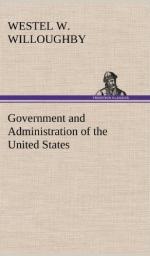[Footnote 1: As Lincoln expressed it in his message of July 4, 1861: “The States have their status in the Union, and they have no other legal status.... The Union is older than any of the States, and in fact, it created them as States.”]
To maintain the “Compact Theory” it is necessary to show that the “Continental Congress” had no properly delegated national powers, and to it the character of a national government could not fitly be applied, and that the colonies when they separated from England remained independent of each other, because as colonies they had been independent. Therefore, that the initial clause of the Preamble to the Constitution “We the people of the United States” referred not to all the people of the United States in their collective capacity, but to the people of the several States.
In fine, admitting, as all do, the Continental Congress to have been a revolutionary body, exercising undelegated powers, the question is, Was it, or was it not, a de jure, as well as de facto national government, and this is a question that cannot be answered absolutely.
These opposing views of the character of our constitution have been stated not with the idea of proving either of them to be the correct one, but solely to indicate the lines along which political parties have fought their battles. Thus, it is hoped, the student will be prepared for an intelligent consideration of the various political parties that have existed in the course of his country’s history.
To complete the statement of the underlying causes and fundamental principles that have directed the course of our national politics, it is necessary to give at least some short account of the natural causes that have operated irresistibly to divide the North and the South in their political thoughts and actions.
Why is it that slavery flourished in the South, but languished and was gradually abolished in the North? Why is it that the stronghold of the States’ Rights doctrine of nullification and of secession was in the South, and the citadel of the Unionists in the North? Why is it that to-day the debate between high and low customs duties, is, to a very considerable extent, a discussion between the New England and Middle States and the Southern States?
To all these questions a very satisfactory answer can be found in the different physical characteristics of the North and South. The nature of the soil and climate, as well as the character of the settlers, predetermined for the Southern colonies an agricultural character, and for the colonies of the North a commercial and industrial character; and, already by the end of the eighteenth century we find in them a marked difference of political and social life.




